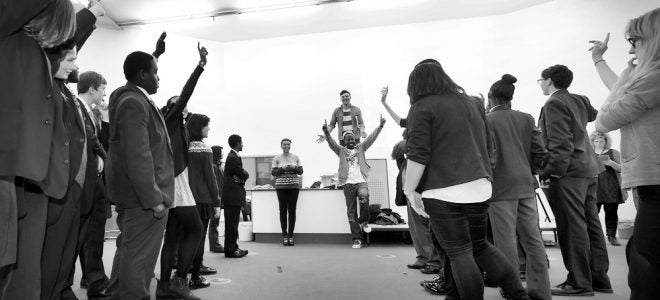

Andy Ridgeway is a four-time recipient of Boise State’s President’s Writing Award and the co-founder of the Boise Ethos Project, a campus organization that works to help students develop the advocacy skills they need to create positive change in their community. He will graduate Boise State in the fall of 2016 with a major in English literature and a minor in gender studies.
Don’t let the tattoos and the Misfits t-shirt fool you: Victor Castaneda is not a typical college student.
Victor defies many of the stereotypes that come to mind when people think of college: he doesn’t live on campus, his parents didn’t purchase him a meal plan and he spends far more time changing diapers than he does playing beer pong.
In fact, Victor doesn’t get to spend that much time on campus at all. Since enrolling at Boise State University in the spring of 2014, he hasn’t been able to go to any football games or get involved with any campus organizations. Unlike many of his classmates, he’s never rushed a fraternity or participated in student government.
According to its governing code, Boise State University’s student government, the Associated Students of Boise State University (ASBSU), is supposed to “advocate for students, empowering them with a voice on campus… to facilitate direct student engagement in the campus experience.”
Unfortunately, it requires a certain amount of time and economic privilege to participate in extracurricular activities like student government. This puts non-traditional students like Victor at a structural disadvantage, and ensures that they remain alienated from the student body’s official decision-making process.
“I can’t join clubs,” Victor says “because clubs demand a lot.”
While Victor would like to be more involved on campus, he, like many students at Boise State University, has other responsibilities that come first. His wife, Nicole, is a doctor in the third year of her residency; her schedule is hectic and unpredictable. Their son, Sebastian, is four years old and their daughter, Juliet, is still breastfeeding. Both children require constant supervision, which can make it difficult (and expensive) for Victor, a full-time parent, to spend time on campus.
Victor’s situation is increasingly common, but it falls far outside the purview of the “traditional” student experience. His schedule and his responsibilities make it difficult for him to access many of the resources and opportunities that other students take for granted — including the ability to participate in the student body’s formal decision-making process.
A non-traditional student, according to an article by Stephen G. Pelletier in Public Purpose, the journal of the American Association of State Colleges and Universities, is any student who postpones “enrollment into postsecondary education; attends college part-time; works full time; is financially independent for financial aid purposes; has dependents other than a spouse [or] is a single parent.”
The number of students who fit this definition is increasing nationwide. According to a 2015 report published by the Georgetown Center for Education and the Workforce, approximately 70-80 percent of undergraduate students are employed, with 40 percent of all undergraduate students working at least 30 hours a week.
This sort of work schedule doesn’t leave a lot of time for campus activism or extracurricular activities. As a result, many student leadership positions are occupied by the most economically-privileged students; that is, the students who aren’t already committed to raising a family or working full-time to pay off student loans.
This is a particularly pressing problem for Boise State University. According to the university’s 2016 enrollment data, 20 percent of the student body is between the ages of 25 and 34 and an additional 11 percent of the student body is 35 or older. The average age of a degree-seeing student at Boise State is 24.5 years old. In other words, at least one-third of the student body is comprised of non-traditional students.
This percentage isn’t always reflected in the makeup of campus organizations like ASBSU, which tend to be dominated by younger students, many of whom attend Boise State full-time. These are students who can afford to take on additional extracurricular activities. Non-traditional students, on the other hand, are less likely to be financially dependent on their parents, more likely to have dependents of their own and, as a result, are more likely work part-time or full-time.
This means non-traditional students are less likely to seek out leadership positions on campus: a student who is working 30 hours a week, raising a family and taking classes doesn’t have time to participate in extra-curricular activities or run for student body president. Consequently, non-traditional students exercise very little influence over the student body’s formal decision-making process.
Why does this matter? Well, for one thing, ASBSU distributes hundreds of thousands of dollars a year to different student groups and organizations on campus. If ASBSU is primarily comprised of traditional, full-time students, that money is more likely to go to organizations and events that cater to that particular campus demographic.
When ASBSU decides which events receive funding and which ones don’t, it’s actually setting the student body’s political (or apolitical) agenda for the semester. Leaving non-traditional students out of this decision-making process makes it harder to address the issues that disproportionately affect them, like Boise State’s employee hours cap or the lack of childcare facilities on campus.
If student leaders and university administrators really want to establish a truly democratic campus culture, they must find creative solutions to the obstacles that prevent non-traditional students like Victor from getting involved on campus.
The university can start by expanding its childcare facilities. Idaho has the 9th highest birthrate in the county, according to Business Insider. Its southern neighbor, Utah, has the highest. Universities like Weber State have adapted to these regional demographics by offering low-cost childcare for up to four hours at a time. If Boise State were to offer something similar, non-traditional students would be better positioned to get involved with events and organizations on campus.
In the meantime, ASBSU can restructure itself to reflect the diverse interests of the student body by moving away from the current model, which favors representative democracy, towards a new system that favors direct democracy. In this new system, the ASBSU Assembly would continue to write and propose resolutions, but the student body would vote in online, campus-wide referendums to either affirm or reject these proposals. Non-traditional students like Victor would no longer be forced to choose between personal commitments (like work and family) and their desire to participate in the student-body’s decision-making process.
While this might seem like a radical departure from the current ASBSU model, it wouldn’t have to happen overnight. Besides, removing the barriers that prevent non-traditional students from participating in campus politics is the only way to establish a campus culture that caters to the needs of traditional and non-traditional students alike.